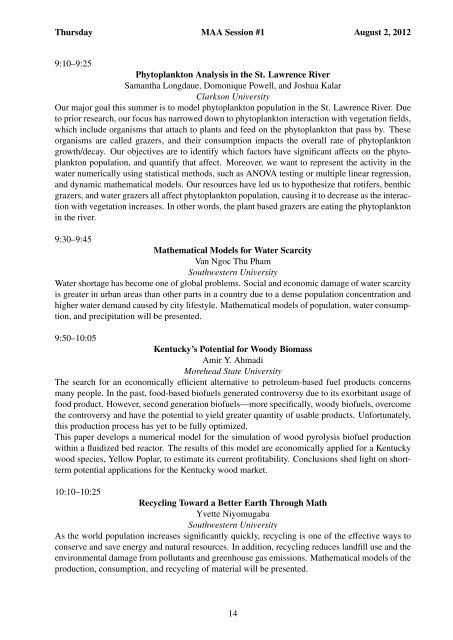Pi Mu Epsilon - Mathematical Association of America
Pi Mu Epsilon - Mathematical Association of America
Pi Mu Epsilon - Mathematical Association of America
You also want an ePaper? Increase the reach of your titles
YUMPU automatically turns print PDFs into web optimized ePapers that Google loves.
Thursday MAA Session #1 August 2, 2012<br />
9:10–9:25<br />
Phytoplankton Analysis in the St. Lawrence River<br />
Samantha Longdaue, Domonique Powell, and Joshua Kalar<br />
Clarkson University<br />
Our major goal this summer is to model phytoplankton population in the St. Lawrence River. Due<br />
to prior research, our focus has narrowed down to phytoplankton interaction with vegetation fields,<br />
which include organisms that attach to plants and feed on the phytoplankton that pass by. These<br />
organisms are called grazers, and their consumption impacts the overall rate <strong>of</strong> phytoplankton<br />
growth/decay. Our objectives are to identify which factors have significant affects on the phytoplankton<br />
population, and quantify that affect. Moreover, we want to represent the activity in the<br />
water numerically using statistical methods, such as ANOVA testing or multiple linear regression,<br />
and dynamic mathematical models. Our resources have led us to hypothesize that rotifers, benthic<br />
grazers, and water grazers all affect phytoplankton population, causing it to decrease as the interaction<br />
with vegetation increases. In other words, the plant based grazers are eating the phytoplankton<br />
in the river.<br />
9:30–9:45<br />
<strong>Mathematical</strong> Models for Water Scarcity<br />
Van Ngoc Thu Pham<br />
Southwestern University<br />
Water shortage has become one <strong>of</strong> global problems. Social and economic damage <strong>of</strong> water scarcity<br />
is greater in urban areas than other parts in a country due to a dense population concentration and<br />
higher water demand caused by city lifestyle. <strong>Mathematical</strong> models <strong>of</strong> population, water consumption,<br />
and precipitation will be presented.<br />
9:50–10:05<br />
Kentucky’s Potential for Woody Biomass<br />
Amir Y. Ahmadi<br />
Morehead State University<br />
The search for an economically efficient alternative to petroleum-based fuel products concerns<br />
many people. In the past, food-based bi<strong>of</strong>uels generated controversy due to its exorbitant usage <strong>of</strong><br />
food product. However, second generation bi<strong>of</strong>uels—more specifically, woody bi<strong>of</strong>uels, overcome<br />
the controversy and have the potential to yield greater quantity <strong>of</strong> usable products. Unfortunately,<br />
this production process has yet to be fully optimized.<br />
This paper develops a numerical model for the simulation <strong>of</strong> wood pyrolysis bi<strong>of</strong>uel production<br />
within a fluidized bed reactor. The results <strong>of</strong> this model are economically applied for a Kentucky<br />
wood species, Yellow Poplar, to estimate its current pr<strong>of</strong>itability. Conclusions shed light on shortterm<br />
potential applications for the Kentucky wood market.<br />
10:10–10:25<br />
Recycling Toward a Better Earth Through Math<br />
Yvette Niyomugaba<br />
Southwestern University<br />
As the world population increases significantly quickly, recycling is one <strong>of</strong> the effective ways to<br />
conserve and save energy and natural resources. In addition, recycling reduces landfill use and the<br />
environmental damage from pollutants and greenhouse gas emissions. <strong>Mathematical</strong> models <strong>of</strong> the<br />
production, consumption, and recycling <strong>of</strong> material will be presented.<br />
14
















